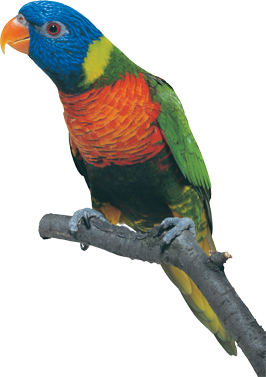Profiles
RAINBOW LORIKEET
(TrichoglossusHaematodus)
Family: Parrot
Origin: Widespread in timbered area of eastern Australia from Cape York to Tasmania
Size: 320mm including a 135mm tail
Description:
This cheeky bird has a violet-blue head with lighter blue feather shafts on the collar and yellow-green on the nape. The rest of the upper parts of the body including the tail are green.
The breast and sides of the body are bright orange-yellow and barred with dark blue. And in the centre of the belly there is a large patch of deep violet-blue. The thighs, lower flanks and under tail coverts are green with yellow markings with a narrow yellow band on the underside of the flight feathers. Its eyes are orange-red, the beak is coral and the legs are grey-green.
The hen is very similar in colour to the male and the immature chicks have duller, shorter tails.
Care:
In the wild these boisterous little birds like to nest in the hollow limbs and holes found in trees. When kept as pets nest boxes or hollow limbs can be placed in the aviary. And to keep your birds truly happy it’s also a good idea to plant some non-poisonous naïve plants for the birds to “hide in” and to chew on.
It’s also a good idea to spread fresh sawdust on the floor of the aviary but in one corner only and change it as soon as it becomes soiled.
All food and water dishes must be kept clean and fresh nectar mix needs to be given each day. And because of their liquid diet, droppings are very watery so the best way to house these birds is in suspended aviaries and make cleaning much easier.
Eats:
As a rule these birds do not eat seed – they are nectar eaters and so need a special nectar mix both wet and dry in constant supply. Fresh apples, grapes, bananas, insects and their larvae, and pollen from eucalyptus blossoms and native trees also need to be supplied to provide a balanced diet.
Features: The mouth parts of Lorikeets have been modified to allow them to easily collect a diet of plant nectar. The female usually lays two eggs that she incubates on her own for 23 days, but the male helps feed the chicks once they have hatched.
Call:
When flying together in a flock these birds give out a continuous screech and a shrill chatter when feeding and a soft twitter when they are feeling safe and relaxed.
Personality:
Lorikeets appear to be fearless and in their search for food will scramble over all visitors who come to see them in the various parks where they are fed with a diluted honey mixture.
